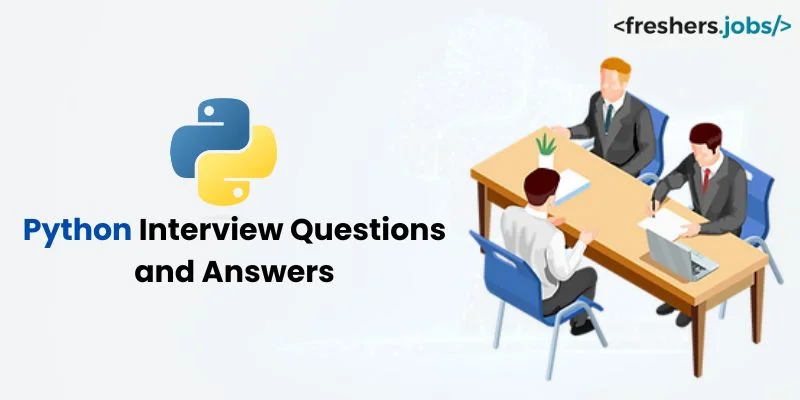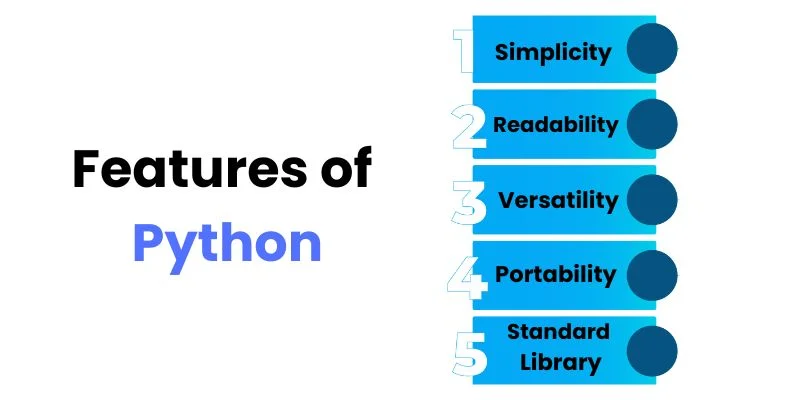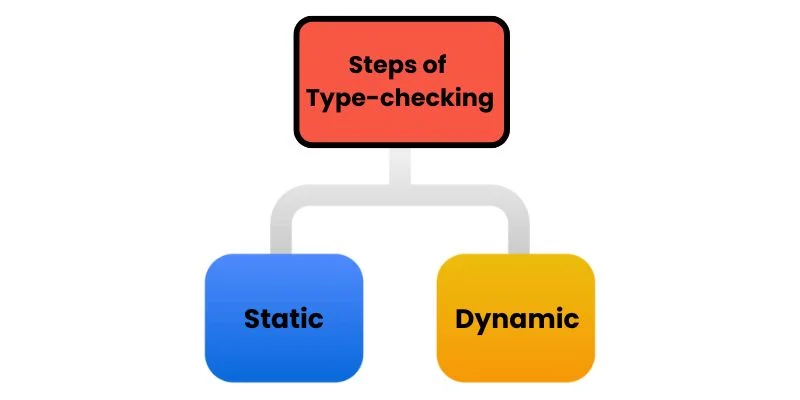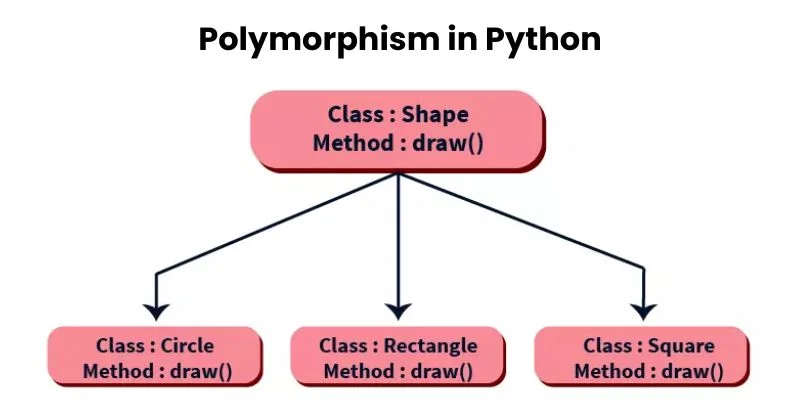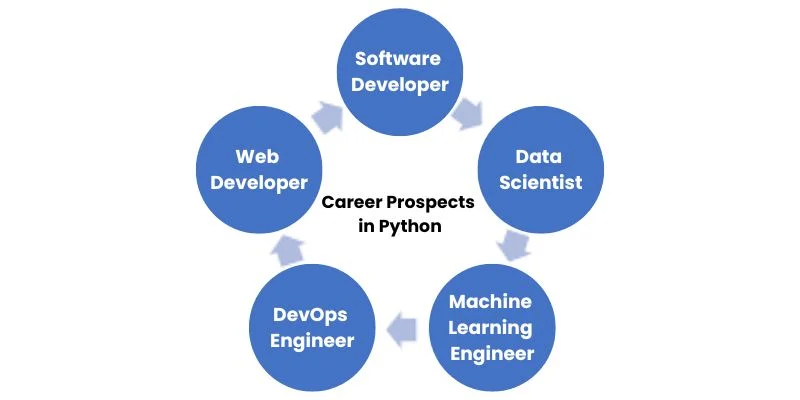Python is defined as an open-source programming language that can be easily learned. It is one of the most preferred programming languages and has many career opportunities. In this blog, we will explore the top 50 Python Interview Questions and Answers tailored for fresh candidates to learn the commonly asked questions in the Python Interview. Are you looking for more Python-related job openings? Visit Freshers Jobs for better career opportunities.
Python Questions and Answers
Core Python Interview Questions & Answers
- What is Python?
Python is an interpreted, high-level language known for its readability and simplicity. It is compatible with procedural, object-oriented, and functional programming paradigms.
- What are the key features of Python?
There are several features in Python. They are:
- Simplicity
- Readability
- Versatility
- Portability
- Extensive standard library.
Python is also compatible with automatic memory management and dynamic type checking. If you are looking for Python-related job openings that align with your skills and abilities, explore Free Alert Job.
- What are the benefits of Python?
- Python is a general-purpose programming language that prioritizes readability and has a simple syntax that reduces the amount of work required to maintain programs. The language also enables third-party packages that promote modularity and code reuse, are fully open-source, and have scripting capabilities.
- Its dynamic typing, binding, and high-level data structures draw a large developer community for rapid application development and deployment.
- State the differences between Lists and Tuples.
| Lists | Tuples |
| Lists are mutable. Their elements can be modified after their creation. | Tuples are immutable. Their elements cannot be modified after their creation. |
| Lists are denoted by square brackets []. | Whereas, Tuples are denoted by parentheses (). |
- Distinguish between == and is in Python?
The function of the ‘==’ operator is to check for the equality of the value. The ‘is’ operator checks whether the given 2 values refer to the same object in memory.
As we explored the core Questions and Answers in Python, let’s discuss the Intermediate Python Interview Questions and Answers for Freshers.
- Define “Dynamically typed language” in Python.
Its dynamic typing, binding, and high-level data structures draw a large developer community for rapid application development and deployment. Before we can comprehend a dynamically typed language, we must first understand what typing is. In programming languages, type-checking is referred to as typing. Since strongly typed languages (like Python) do not support “type-coercion” (implicit conversion of data types), “1” + 2 will produce a type error. Conversely, a language with weak typing, like Javascript, will only provide “12” as the output.
Two steps can be involved in type-checking:
- Static: Before execution, data types are verified.
- Dynamic: During execution, data types are verified.
Since Python is an interpreted language, type verification occurs dynamically while a statement is being executed, line by line. Python is a dynamically typed language as a result.
- Define an interpretive language.
An interpretive language puts its statements into action line by line. Languages like Python, Javascript, R, PHP, and Ruby are excellent examples of interpretive languages. Interpreted programs execute straight from the source code; there is no need for a compilation stage in between.
- What is the scope of Python?
Each object operates inside a scope. In Python, a scope is a section of code where an object is still relevant. Namespaces provide each object inside a program with a distinct identity. But there’s also a scope established for these namespaces where you can utilize their objects without a prefix. Here are a few instances of scope that Python creates while executing code:
- The local objects available in the current function are called a local scope.
- The items accessible since the beginning of code execution are called the global scope.
- The global objects of the current module that are accessible within the program are referred to as a module-level scope.
- The outermost scope contains all of the program’s built-in names that can be called. The name is found by searching the items in this scope last.
- What are the differences between Global and Local variables in Python?
| Global Variables | Local Variables |
| It is possible to access Global variables which are defined outside of the function from anywhere in the program. | Local variables are restricted to access from within a function in which they are defined. |
- What is the function of the __str__ method in Python classes?
A special function in Python classes called __str__ returns an object’s string representation. When an object is supplied to print() or the str() function is used on it, it is called. It is frequently employed to provide the item a representation that is readable by humans.
Python Interview Questions and Answers for Testers.
- What is Python primarily used for in software testing?
Python is commonly used in software testing for tasks like test automation, test script development, and building test frameworks due to its simplicity, readability, and extensive libraries.
- Explain the concept of unit testing in Python.
In Python, unit testing is evaluating distinct program units or components separately to make sure they function as intended. Unit tests are often written and run using Python’s unit test or py test frameworks.
- What is the function of the assert statement in Python testing?
The assert statement in Python verifies that a given condition is true during testing. An assertion error is raised if the condition is false, indicating a test failure.
- Can we call a Parent class without its Instance class?
Yes, we can call a parent class without its Instance class if the base class is a static method or if it is an instance that is instantiated by other child classes.
- What is the difference between setUp() and tearDown() methods in Python test classes?
The setUp() method is called before each test method in a test class and is used to set up any necessary preconditions or resources needed for the tests.
| setUp() | tearDown() |
| The setUp() method is called before each test method in a test class and is used to set up any necessary preconditions or resources needed for the tests. | The tearDown() function is invoked following each test method, and its purpose is to free up resources and perform any necessary takedown actions. |
If you are willing to enhance your Python skills, you can opt for Top 10 Python Institutes in Chennai.
So far we discussed the core Questions and Answers based on Python for Testers. Let’s delve into the Intermediate Python Interview Questions and Answers for Testers.
- Explain the concept of test coverage in Python testing.
Test coverage in Python testing refers to how much of the codebase is exercised by the tests. It assists in evaluating how comprehensive the testing procedure was and points up sections of the code that could require more testing.
- State the differences between override and new modifiers.
The compiler is told to utilize the new implementation rather than the base class method using the new modifier. When a base class function must be overridden inside a child class, the Override modifier is handy.
- What is the use of finalize?
The Finalize method is used to tidy up and release unmanaged resources before invoking the Garbage Collection function. This facilitates the completion of memory management duties.
- Explain the concept of parameterized testing in Python.
In Python, parameterized testing entails executing the same test logic using various input parameter sets. It allows testers to efficiently test multiple scenarios using a single test method, improving test coverage and reducing code duplication.
- What are some common best practices for writing effective Python tests?
Some common best practices for writing effective Python tests include keeping tests independent and isolated, using descriptive test method names, organizing tests into logical groups, prioritizing readability and maintainability, and frequently reviewing & updating tests as the codebase evolves.
If you are looking for Python-related jobs in Chennai, explore Fresher Jobs in Chennai for more choices.
OOPS-based Python Interview Questions and Answers.
- What is a class in Python?
In Python, a class serves as an object’s blueprint. It describes the traits and purposes of class objects.
- What is an object in Python?
An object in Python is an instance of a class. It represents a particular thing with distinct qualities and actions.
- What is inheritance in Python?
Inheritance in Python creates a new class (subclass) by deriving properties and behaviors from an existing class (superclass). It stands for a particular thing with distinct qualities and actions.
- What is encapsulation in Python?
In Python, encapsulation is the grouping of methods (functions) that manipulate the data and data (attributes) into a single unit, called a class. It allows for data hiding and prevents direct access to an object’s internal state from outside the class.
- What is polymorphism in Python?
In Python, polymorphism is the capacity of various objects to react differently to the same method or function call. This allows for flexibility and adaptability in code design.
As we discussed the core OOPs based Questions and Answers, let’s delve into the intermediate OOPs-related Python Interview Questions and Answers for freshers.
- What are constructors in Python classes?
Constructors in Python classes are special methods (__init__()) that are automatically called when an object of the class is created. They are used to initialize the object’s attributes or perform any necessary setup operations.
- What is method overriding in Python?
In Python, method overriding happens when a subclass offers a specific implementation of a method that is already specified in the superclass. Thus, the behavior of inherited methods can be altered by subclasses.
- What is method overloading in Python?
Python does not explicitly support method overloading, in contrast to other programming languages like Java. However, Python allows a single method to have different implementations based on the number or types of its arguments, which achieves a similar effect.
- What is the self keyword in Python?
A reference to the active instance of the class in Python is called self. It is used within class methods to access and modify the object’s attributes and call other methods.
- How do you create a child class (subclass) in Python?
In Python, a child class (subclass) is created by specifying the superclass in parentheses after the class name.
For example:
class ChildClass(SuperClass):
# class body
Pandas-related Python Interview Questions and Answers.
- What is Pandas in Python?
Pandas is an open-source Python package for analyzing and manipulating data. It provides high-performance, easy-to-use data structures and analysis tools, particularly for structured data such as tabular and time series data.
- What do Pandas provide the key data structures?
The two primary Data Structures that Pandas provides are Series and DataFrame.
- A series is an object that resembles a one-dimensional array and can hold any kind of data. It is comparable to a NumPy array but has built-in labels and other features.
- A data frame is a labeled data structure that is two-dimensional and may have different columns. It can be considered a spreadsheet or table with rows and columns.
- How do you read data from a CSV file into a Pandas DataFrame?
Pandas’s read_csv() function can read data from a CSV file into a DataFrame.
For example:
import pandas as pd
df = pd.read_csv(‘data.csv’)
- What is the purpose of the head() and tail() methods in Pandas?
The head() method displays the first few rows of a DataFrame, while the tail() method displays the last few rows. By default, both methods display the first or last five rows, but you can specify the number of rows to display as an argument.
- Explain the difference between loc and iloc in Pandas.
- loc is used for label-based indexing, which means you can select rows and columns from a data frame using labels (e.g., column names or index labels).
- iloc is used for integer-based indexing, which means you can select rows and columns from a DataFrame using integer indices, similar to how you would index a NumPy array.
Numpy-related Python Interview Questions and Answers.
- What is NumPy in Python?
A set of mathematical functions to effectively work with huge, multi-dimensional arrays and matrices, as well as a Python library for numerical computing, are provided by NumPy. It is extensively utilized in machine learning, data analysis, and scientific computing.
- What are the key features of NumPy?
The robust N-dimensional array object (ndarray) that NumPy offers makes it possible to store and manipulate huge datasets effectively. It also offers various mathematical functions for array operations, including basic arithmetic, linear algebra, statistics, etc.
- How do you create a NumPy array in Python?
You can create a NumPy array using the numpy.array() function by passing a Python list or tuple as an argument.
For example:
import numpy as np
arr = np.array([1, 2, 3, 4, 5])
- Explain the concept of broadcasting in NumPy.
Broadcasting in NumPy refers to the ability to perform arithmetic operations between arrays of different shapes and sizes. When operating on arrays with different shapes, NumPy automatically broadcasts the smaller array to match the shape of the larger array, making it possible to perform element-wise operations without explicitly reshaping the arrays.
- What is the difference between a NumPy array and a Python list?
NumPy arrays are homogeneous and fixed-size, meaning they contain elements of the same data type and have a predefined shape. On the other hand, Python lists can contain elements of different data types and sizes that are dynamically resizable. NumPy arrays offer more efficient storage and operations for numerical computations than Python lists.
Python Interview Questions and Answers based on Python Libraries.
- What is the purpose of the NumPy library in Python?
NumPy is a core Python package for numerical computation. Large, multidimensional arrays, matrices, and a number of mathematical functions are supported for effective manipulation of these arrays.
- Explain the role of the Pandas library in Python data analysis.
Pandas is a robust Python package for handling and analyzing data. It provides data structures like DataFrame and Series, allowing for easy handling of structured data such as tabular and time-series. Pandas also offers data cleaning, filtering, grouping, and aggregation functionalities.
- What is Matplotlib used for in Python?
Matplotlib is a Python plotting library for creating static, interactive, and animated visualizations. It provides various plotting functions to generate various plots, including line plots, scatter plots, bar plots, histograms, etc.
- Explain the purpose of the scikit-learn library in Python.
A Python machine learning framework called scikit-learn offers quick and easy-to-use data mining and analysis tools. It includes many supervised and unsupervised learning algorithms and utilities for model evaluation, preprocessing, feature selection, and model tuning.
- What is TensorFlow, and how is it used in Python?
Google created the open-source TensorFlow machine learning framework to create and train deep learning models. It offers an adaptable and expandable framework for building neural networks and effectively utilizing tensors for numerical operations. TensorFlow can be used for various tasks, such as image recognition and natural language processing.
So far we explored the core Questions and Answers based on Python Libraries. Now, let’s discuss the Intermediate Python Interview Questions and Answers for freshers based on Python Libraries.
- What is PYTHONPATH?
It is an environment variable that can add more directories when a module or package is imported. The PYTHONPATH variable determines whether imported modules or packages are in the current directories. Furthermore, the interpreter determines which module has to be loaded using this environment variable.
- Explain the purpose of the requests library in Python.
The requests library is a simple and elegant HTTP library in Python used for making HTTP requests and interacting with web APIs. It provides functionalities for sending GET, POST, PUT, DELETE, and other HTTP requests and handling cookies, headers, and authentication.
- What is the purpose of the OpenCV library in Python?
OpenCV is referred to as a Python library for computer vision & image processing tasks. It provides various functionalities for reading, writing, manipulating, and analyzing images and videos. It implements various computer vision algorithms, such as object detection, facial recognition, and image segmentation.
- Explain the role of the NLTK library in Python natural language processing.
A Python module named NLTK (Natural Language Toolkit) is used for natural language processing (NLP) activities. It provides functionalities for text tokenization, part-of-speech tagging, named entity recognition, sentiment analysis, text classification, etc. NLTK also includes corpora and lexical resources for training and testing NLP models.
- What are some advantages of using the SQLAlchemy library in Python for database interaction?
SQLAlchemy is a powerful library in Python used for interacting with relational databases. Some advantages of using SQLAlchemy include its object-relational mapping (ORM) capabilities, which allow developers to work with database tables as Python objects, its support for multiple database backends, its flexibility and extensibility, and its rich ecosystem of plugins and extensions for advanced database operations.
Career Prospects in Python
Python Developers are in great need in India. As per Naukri, more than 100,000 career opportunities are available in Python for freshers. Due to the flexibility of the language, several companies, like IBM, Netflix, Google, etc., are hiring freshers with Python knowledge. The annual Salary for Python Developers is around 4.5 lakhs in India. This can vary based on experience, location, company, skills, job role, etc. Given below are some Python-related job roles.
Software Developer
The major duty of a Python Software Developer is to design, create, and manage software applications utilizing the Python programming language and associated frameworks like Flask, Django, or PyQt. Python programmers are essential to developing scalable and effective solutions for various sectors, whether designing backend systems, desktop apps, or web applications.
Data Scientist
Python is a widely used language among Data Scientists for Predictive Modeling, Machine Learning, and Data Analysis activities. Python provides data scientists the tools to analyze information, conclude, and create machine learning models to address challenging business issues. These tools include NumPy, Pandas, and Scikit-learn. Data Scientists use Python’s adaptability and vibrant community to mine large amounts of data for valuable insights that inform organizational decision-making.
Machine Learning Engineer
The creation, application, and deployment of machine learning models and systems is the area of expertise for machine learning engineers. Due to its many machine learning packages, including TensorFlow, Keras, and PyTorch, Python is the preferred language for creating and refining neural networks, creating AI-driven apps, and implementing models in real-world settings. Python is a tool that machine learning engineers use to create creative solutions for problems like recommendation systems, natural language processing, and picture recognition. In numerous companies like Accenture, hire freshers for Machine Learning Engineer job roles.
DevOps Engineer
DevOps engineers use Python for pipeline management, automation, and continuous integration/deployment (CI/CD). The robust ecosystem of tools and frameworks, including Ansible, Docker, and Kubernetes, combined with Python’s scripting powers, allow DevOps professionals to automate time-consuming processes, provision and manage infrastructure, and coordinate intricate deployment workflows. Proficiency in Python is imperative for optimizing software development procedures, enhancing operational effectiveness, and guaranteeing the dependability and expandability of software frameworks.
Web Developer
Python is a leading web development language for creating scalable and dynamic web applications. Web Developers use Python web frameworks such as Django and Flask to build content management systems (CMS), RESTful APIs, and powerful backend systems. Python is a great option for rapid development because its readability and simplicity let web developers quickly create feature-rich online apps. Python’s flexibility extends to front-end programming, where tools like React.js and Vue.js and frameworks like Django templates are used.
As an open-source programming language, coupled with its ease of learning, has made it immensely popular among freshers. With its broad spectrum of career opportunities spanning various industries, mastering Python can open doors to exciting job prospects and rewarding career paths. This blog will equip freshers with the top 50 Python Interview Questions and Answers.


